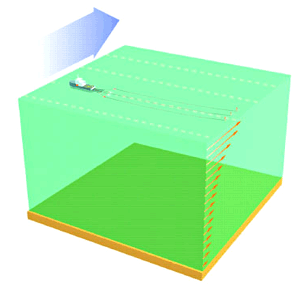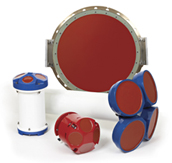Efficient Seismic Survey Operations
Managing Ocean Currents for Efficient Seismic Survey Operations

The continued demand for oil and gas drives exploration and production in to more and more complex environments. Operating efficiently in these complex environments necessitates a precise understanding of the physical environment. Modern exploration techniques include: increased towed streamer lengths, higher streamer counts, tighter spacing, ocean bottom seismic and electro magnetic geophysical sensing. More and more often these state-of-the-art systems are deployed in deep water and/or ocean environments with complex ocean currents. Given the risks and high operating cost associated with these environments, it is critical to understand the ocean’s physical characteristics and their impact on the efficiency and safety of seismic survey operations. In recent years, Acoustic Doppler Current Profiler (ADCP) have become the tool of choice onboard survey vessels to provide a clear understanding of real-time current speed and direction profile, playing a crucial role in survey operations.
The Impact of Ocean Currents on Seismic Survey Operations:
Powerful, complex and highly variable surface and subsurface water currents are an inherent component of the world’s oceans. If not properly monitored and incorporated into survey plans, ocean currents can disrupt seismic operations in a number of time-consuming and costly ways, including:
- Gaps in the seismic data along survey lines
Today’s streamers can be deployed with spacing as tight as 25 meters for up to 17 streamers and vessels are being built with reels to accommodate up to 26 streamers with a towable footprint of more than 10 square kilometers – a sizable area by any standard. The pre-programmed “lawn moving” pattern of the seismic vessel is designed to allow for optimal coverage; however, ocean currents can play a significant role on how well the streamers adhere to this
planned track. Surface and near surface currents can result in streamer feathering, or lateral drift. If the currents are understood, the surveyor can adjust his course in real-time to compensate for this drift. However, left unattended, this drift can result in large data gaps requiring costly infill data; and in extreme cases, streamer tangling, resulting in downtime with significant associated cost. - Equipment damage during deployment and recovery
Ocean currents can exert tremendous force on streamer cables and winches. These forces can cause tangling and/or significant damage to equipment during deployment and recovery activities, resulting in lost time and/or costly repairs. In addition to the physical damage to the equipment, the effects of these currents creates an increased risk to the crew. By understanding the forces at work, these events can be managed to coincide with a low flow state, or the vessel can be positioned to a more favorable environment. - Incorrect touchdown positions during Ocean Bottom Seismic (OBS) surveys
Ocean currents have a significant impact on the horizontal travel during the deployment of ocean bottom cables and stand alone sea floor instruments. This is also a factor in the buoyancy dependent recovery of sea floor instrumentation. An accurate knowledge of the ocean current structure provides the data necessary to accurately deploy and efficiently recovery these instruments.
How Current Data is Collected

An Acoustic Doppler Current Profiler (ADCP) is a sonar that measures and records water current velocities at up to 128 points, over a range of up to 1000 meters, through the water column. An ADCP operates by transmitting acoustic pulses into the water column. These acoustic pulses propagate through the water column and are “reflected” by suspended particles which are carried by water currents. The reflected signals (echoes) are received by the ADCP. Echoes arriving later, from deeper in the water column, are assigned greater depths in the velocity profile. This allows the ADCP to form vertical profiles of current velocity. Particles within the current flow moving towards the instrument exhibit higher frequencies while those moving away exhibit lower frequencies. This is the famous Doppler shift, which enables precise measurement of current speed and direction, providing a unique and complete view of the water column.
Teledyne RD Instruments (originally founded as RD Instruments) designed and manufactured the industry’s first ADCP in 1982, and has since sold nearly 15,000 of these instruments for a wide array of current profiling applications. The company’s vessel-mounted family of ADCPs continues to raise the bar, collecting detailed maps of the distribution of water currents through the water column and along the ship’s path – at depths and resolutions previously considered unattainable. In real time, the ADCP has proven time and again to be a crucial tool for in-situ decision-making, allowing surveyors to adapt field operations to improve the safety and efficiency of their operations.
Fugro GEOS
Teledyne RDI’s ADCPs have been used to support seismic survey operations for many years. One of the industry’s largest suppliers of turn-key current monitoring for seismic operations is Fugro Global Environmental & Ocean Sciences (GEOS). Fugro GEOS, a member of the larger Fugro Group, is the world’s leading supplier of meteorological and oceanographic services for offshore and coastal engineering applications.
To date, Teledyne RDI has supplied Fugro Geos with more than 40 ADCPs for installation onboard seismic survey vessels. These ADCPs are integrated with Fugro GEOS SeisADCP software package developed specifically for this application. The SeisADCP package manages the operation of the ADCP system and displays surface current data in real-time as they are gathered. The displays are designed to allow seismic navigators to identify the oceanographic features that may affect operations, such as rapid changes in current velocities (valuable when shooting lines and deploying equipment); longer-term changes in current velocity (necessary when planning the shooting of lines and deploying equipment); and current velocity shear with depth (for stacking streamers and deploying ocean bottom cables).

Conclusion:
Powerful and dynamic ocean currents are a reality for seismic survey operators. Teledyne RD Instruments ADCPs are a proven tool for understanding the physical ocean environment, and allow operators to adjust their survey plans to incorporate, as opposed to fighting, these elements.
For more information on Teledyne RDI’s ADCPs for seismic applications, contact Grant Jennings at Teledyne RD Instruments at +1-858-842-2600.















